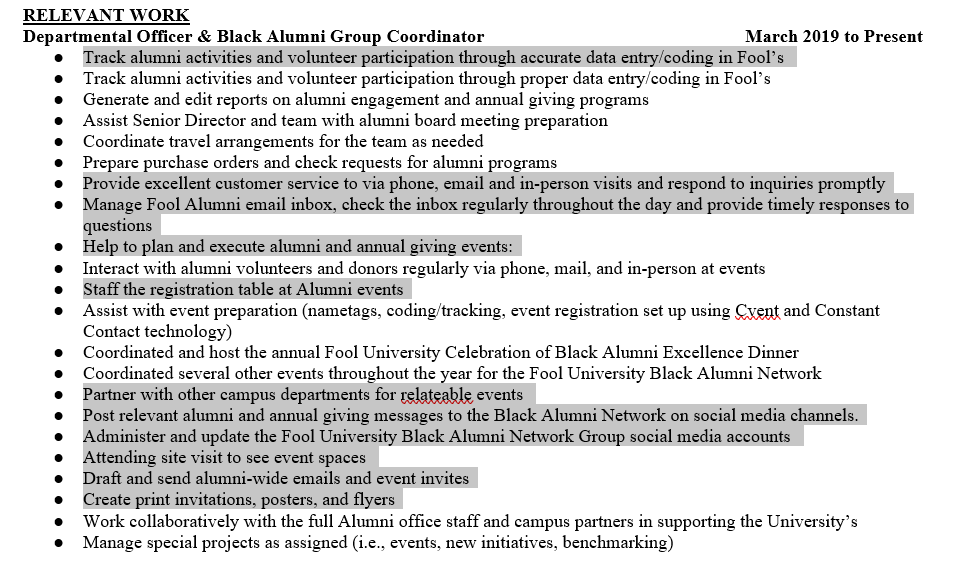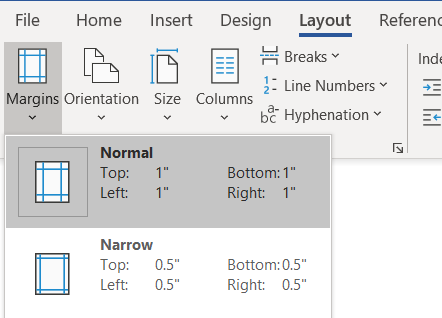Resume Case Study: From College Administration to Government Analyst
One of my favorite things to do is help people get on a better career path. A good friend of mine is taking me up on it for this resume case study.
“Olga” and I met through a mutual friend and have kept in touch since our college days. She graduated two years after I did and has worked for nearby universities ever since; today, she texted me saying me she’s taking the plunge and following her dreams of working for the government (YES GIRL, FOLLOW THOSE DREAMS!!!) She’s asked me to rework her resume for a role as a government analyst, which I’m now sharing with all of you!
Every resume case study on We Want Guac are walkthroughs showing you how to specifically redesign that important piece of paper. Getting a high-paying job requires getting the job offer first, and a killer resume is the way to get there. Note: all identifying information has been either scrubbed or altered, including names, company timelines, and job titles.
This is also A LOT of work. Getting a high-paying job means making a kick-ass resume, which takes time and energy to do. Because these posts get into the weeds, it might also seem tedious at times but well worth the life satisfaction.
And better pay.
Here we go!
About “Olga”
As mentioned above, Olga graduated in 2018 with a Bachelor’s in Global Studies (same as yours truly). Before job-hunting for government roles, she was offered a position at a college she’d spent a few months working for already. Olga decided to accept and worked there for about a year before changing jobs to work for our alma mater. Because this is Fool University we’re talking about, she’s finally decided enough is enough and her talents are better spent elsewhere. Specifically, in pursuit of her original goals of public sector drudgery! (Kidding, kidding…)
So with that, we’re going to rework her resume to pursue these specific roles.
The Pros:
If there’s any industry that translates well to the government sector, it’s academia. Especially academia administration. Her skills and current job tasks are very similar to the responsibilities job ads describe. She’s also kept on top of updating her resume with new job tasks when she changed them. That’s a huge help!
The Cons:
Her resume might fall in the hands of a traditional thinker who won’t like to see the year-long stints. Luckily this isn’t much of a con as job hopping has become much more acceptable; my own resume case study is a perfect example of that. All this means is we’ll need to pack a punch with our wording here.
Another con is she hasn’t yet proofread her resume, but that’s mostly because I eagerly volunteered to do it instead. This means extra work, but that extra work will be worth it.
And we’re off!
Here’s Olga’s current resume layout:
Right away two big things jump out at me: the margin sizes and the fact it’s two pages long. I get why Olga did this. She’s trying to fit as much as possible onto her resume to wow the socks off of HR. I did the same thing, once upon a time, before I wised up. I stopped doing it when I realized how often said HR people print off these resumes. The little warning popups that this document is outside the margins gets irritating, and they’re looking for literally any excuse to narrow down the sea of applicants. So don’t let them cull you because of freaking formatting, of all things.

Color inside the lines and keep everything inside the established standard margins.
There is also zero good reason for this thing to be two pages. If Olga was a high-powered executive with a shitload of CEO-like accomplishments and awards under her belt, then two pages is understandable. But she’s still early in her career, and the two pages are very much not needed; they could even hurt her chances. To prevent that we’re going to have to chop this down to one page. Which, as you’ll see in the Experience section, will actually be a piece of cake.
Education Section
Unless you graduated with Latin honors, don’t put your GPA in your resume. In fact, don’t even put it in if you did get Latin honors (cum laude and up). Just put in the proper Latin phrase you achieved and go on your merry way. The only people that care about your GPA will be snobs and graduate admissions offices. Assume your employer is neither of these things and take them off.
As much as I think community colleges are unsung heroes, the Associate’s doesn’t have a place here. HR software will even trash resumes with an AA degree (anything to narrow it down, remember!) so we’re removing it too.

And just like that, we’ve removed six lines from her busy resume.
Work Experience Section
For this section, you should ONLY add the work experience that’s relevant. This does NOT mean your entire work history. Olga fell into this trap by including less-relevant positions like being a cashier and a bank rep. These jobs are great for experience if you’re trying to get started on a career path, but Olga’s already got years of good experience in her line of work. She doesn’t need to mention her non-relevant jobs when there’s already jobs that are super-relevant staring us in the face.
So we don’t need the cash office, the QA rep, or the bank rep on this resume. Buh-bye.

That leaves us with her three most relevant positions, all of which happen to be in academic administrative roles. The most recent position has a looooooooong list of bullet points the other two do not, despite Olga having spent the same relative amount of time in this job. Time to remove the fluff so we can work with the best material later. We’re going to take out:
- everything accidentally put in twice or redundant
- all of those organizational titles. Don’t need em.

And just like that, we’ve squished everything into one page just by attacking this with the backspace button. Hooray! But there’s still more to trim in the next two sections.
The Skills Section
Very few jobs need a resume Skills section, and I can almost guarantee yours doesn’t either. Olga’s is another resume case study that shouldn’t have a Skills section. Some of her listed skills are soft skills the employer will judge her on in a later stage of the interview process; they don’t know her yet so they can’t take her at her word with something so subjective.
Other things are so obvious that they have no place on a resume – we already know Olga is fluent in English so she doesn’t need to put that here, but being fluent in two other languages is something we can keep elsewhere. Looking over the Skills, the best ones to keep are her multilingual fluency and her software expertise. We’re going to cut this entire section but keep the more relevant skills on hand to pepper through her work experience section.
The Volunteer Section
I edited out the name of this volunteer organization but it’s definitely one you’ve heard of growing up. This is an amazing activity Olga does and will definitely make her stand out/help her bond with the hiring decision-makers. That makes a hell of a topic to discuss when they call Olga in for an interview! Trouble is, Olga unintentionally discourages this by writing down everything she does with them. We’re going to keep that experience in the resume case study, but we’re going to take out the description. Less is more in this case.
Now the Framing
Now that we’ve cut out what we don’t need, we can retool Olga’s resume to frame her in the best possible light.
We’re going to start out with copy/pasting her contact info out from the header and into the document body itself. Then, we’re going to fix the margins so they’re normal again; Microsoft Word 2010 makes this easy in the Layout tab at the top, where you go to Margins on the far left and choose “Normal”.

Once that’s done, we go through it quickly to fix the spacing errors from the transition. We’re also reformatting the resume to make it easier to skim, similar to another resume case study or two you’ll find elsewhere on the blog.
And now we’re going to check out the job ads Olga sent me for the types of roles she’s aiming for. Right away I see these roles are research-heavy, often taking data and applying it to help inform governmental response to it. Event planning, if there is any, will take a back seat to Olga’s analytical skill set. Because of that we’re going to lift phrases directly from the job ad and apply them to what Olga’s been doing. Here’s two of the job responsibilities pulled from these ads:
Independently monitors, coordinates, and integrates specific patterns and trends in public health, global health diplomacy for key personnel.
Actively shares information in the interagency framework and remains abreast of current issues that impact key policymakers and their diverse areas of responsibility.
Taking the jargon from these bullet points and applying them to Olga’s responsibilities, we get something like this:
Independently evaluates all source data and plans pertaining to alumni retention in order to improve engagement efforts for executive policymakers, using specialized software platforms
Actively monitors alumni activities and volunteer participation to fill the gaps in existing departmental offerings and address their professional needs
Boom.
And we continue on down the list until all lines have actionable and specific tasks laid out that speak the hiring manager’s language.
Tidying Up
We are also going to rework her job titles so her current role will be “Departmental Officer and Manager” and past roles “Human Resource Analyst” and “Alumni Coordinator”. Since job titles are arbitrary anyway we’re going to use those that speak better to her task load. As long as you’re using industry-standard titles, you won’t run into trouble.
Once we’re completely done with all formatting and framing there’s one final task Olga should do: have someone familiar with the government sector review it. I’ve leveraged my own resume into an impressive role, but this role is not one in the public sector. Every industry has its hiring quirks, and I may be missing an important one just because I’m on the outside. Keep this in mind and be focused on the ask; even if Olga didn’t already know government workers, she’d likely know who to ask to make an introduction.
And that’s a wrap on Olga’s resume case study! What else should we add to this to help other WWG readers?




This is a really fascinating case study! It covers a lot of stuff my parents said with my CV – both having hired for FTSE 100 companies.
It’s a lot of tips many just don’t realize will hurt their chances at jobs.
Also, I’ve never heard of FTSE before but it looks comparable to the Fortune 100 (better known as 500) stateside!